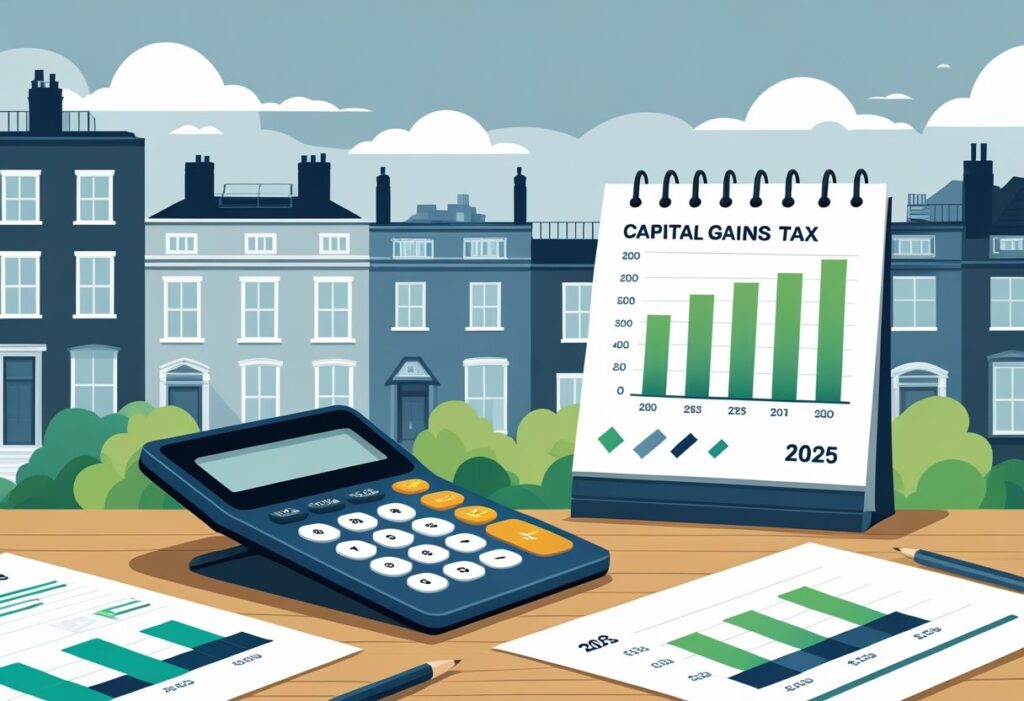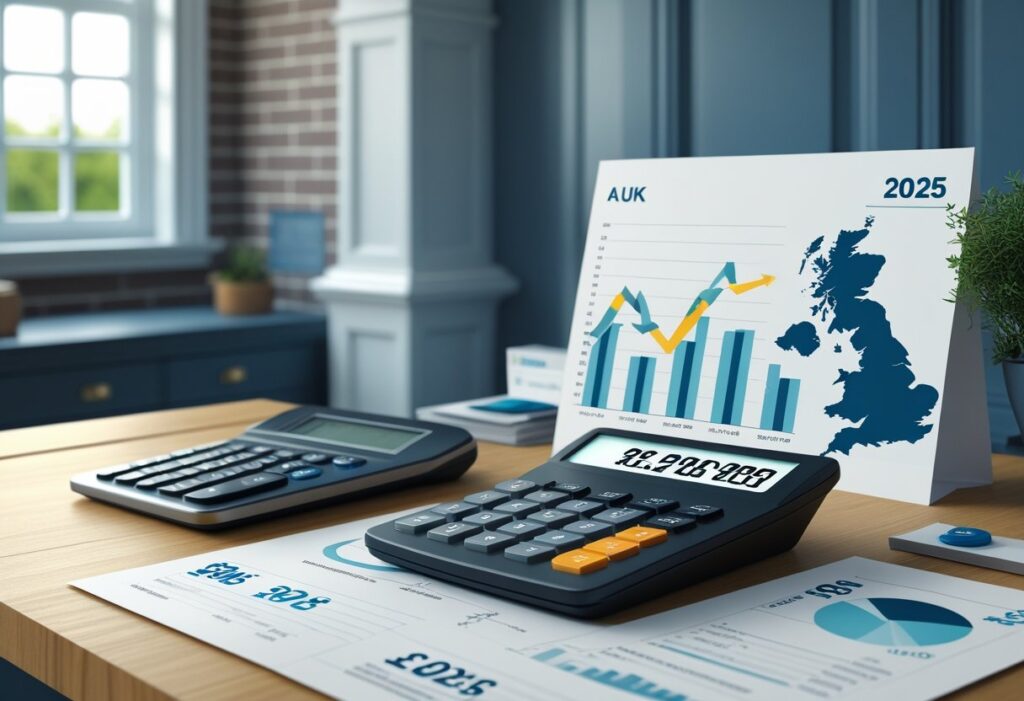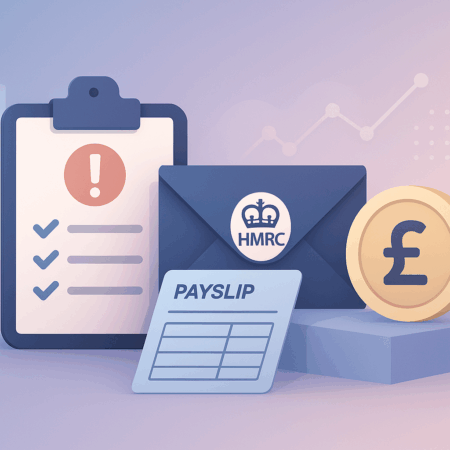Working out Capital Gains Tax (CGT) on UK property can be straightforward with the right tools. In August 2025, the rules and rates for CGT are clear, and online calculators can give an accurate estimate in minutes. A Capital Gains Tax UK property calculator uses your purchase price, sale price, ownership dates, and any reliefs to work out exactly how much tax is due.

For those selling a property that is not their main residence, CGT applies to the profit, not the total sale price. The calculator applies the correct 2025/26 tax-free allowance of £3,000 and the current residential property rates of 18% or 24%, depending on income level. This ensures the estimate reflects the latest HMRC guidance.
By understanding how the calculator works and the key rules in place for August 2025, anyone can prepare for a property sale with confidence. This approach helps avoid surprises and supports better financial planning before the transaction completes.
How the Capital Gains Tax UK Property Calculator Works
A UK property capital gains tax calculator uses key financial details to work out the taxable profit from selling or disposing of a property. It applies the correct tax rates for the relevant tax year and shows the estimated Capital Gains Tax (CGT) owed.
Inputting Asset Details
The first step is to enter accurate property transaction data. This includes the purchase price, selling price, and the disposal date.
Users also need to provide allowable costs, such as legal fees, estate agent charges, and qualifying improvement expenses. These are deducted from the gain to reduce the taxable amount.
If the property was a main residence for part of the ownership period, the calculator may prompt for occupancy dates to apply Private Residence Relief.
Entering incorrect or incomplete figures can lead to inaccurate results. It is important to use documented amounts from contracts, invoices, and HMRC-approved records.
Selecting the Relevant Tax Year
The tax year determines which CGT rates and allowances apply. In the UK, the tax year runs from 6 April to 5 April of the following year.
A disposal date of, for example, 1 August 2025 falls in the 2025/26 tax year. The calculator uses this to apply the correct annual exempt amount and rate structure.
Rates for residential property differ from those for commercial property or other assets. In August 2025, higher-rate taxpayers pay 24% on residential property gains, while basic-rate taxpayers pay 18%.
Choosing the wrong tax year could result in overestimating or underestimating tax liability, as rates and allowances can change annually.
Calculating Profits and Gains
The calculator works out the capital gain by subtracting the purchase price and allowable costs from the selling price.
Formula:Selling Price – (Purchase Price + Allowable Costs) = Capital Gain
If the result is negative, this is a capital loss, which can be offset against other gains.
The tool then applies the annual exempt amount (tax-free allowance) for the relevant year. The remaining taxable gain is then charged at the applicable CGT rate based on the taxpayer’s income band.
Some calculators also factor in adjustments for jointly owned property by splitting the gain between owners.
Understanding Your Results
The output shows the estimated CGT owed, often broken down into:
- Gross gain before reliefs and allowances
- Taxable gain after deductions
- CGT due based on the applicable rate(s)
Some calculators display a side-by-side comparison of rates for basic and higher-rate taxpayers. This helps users see the impact of income level on CGT liability.
It is important to note that results are estimates. Final figures depend on HMRC’s assessment, especially if other gains or losses in the same tax year affect the calculation.
Key Rules for UK Capital Gains Tax on Property in August 2025

Capital Gains Tax (CGT) applies when an individual disposes of a UK residential property that has increased in value. The tax is calculated on the gain after deducting allowable costs, reliefs, and any available tax-free allowance.
The applicable rate, the size of the annual exempt amount, and the reporting deadline directly affect the final CGT liability.
Current Capital Gains Tax Rates
For the 2025/26 tax year, CGT rates on UK residential property remain higher than those for most other assets. Basic rate taxpayers pay 18% on gains within the basic rate band. Higher and additional rate taxpayers pay 24% on residential property gains.
The rate depends on the individual’s total taxable income and the size of the gain. If part of the gain falls within the unused basic rate band, that portion is taxed at 18%, and the remainder at 24%.
These rates apply after deducting the annual exempt amount and any reliefs, such as Private Residence Relief for periods when the property was the owner’s main home.
| Taxpayer status | CGT rate on residential property |
|---|---|
| Basic rate | 18% |
| Higher/additional rate | 24% |
The rates differ from those for other chargeable assets, where the higher rate is 20%.
Annual Exempt Amount and Allowances
The annual exempt amount for 2025/26 is £3,000 for individuals and £1,500 for most trusts. This is the maximum gain that can be realised in the tax year without paying CGT.
This allowance has been reduced in recent years, down from £6,000 in 2023/24 and £12,300 in 2022/23. The lower threshold means more property disposals will result in a CGT liability.
The exempt amount applies across all chargeable gains in the year, not just property. If multiple assets are sold, gains are added together before deducting the allowance.
Taxpayers can also reduce their CGT bill by deducting allowable costs, such as purchase price, legal fees, stamp duty, and capital improvement expenses.
Reporting and Deadlines
Since April 2020, UK residents must report and pay CGT on the sale of UK residential property within a set period. As of August 2025, the deadline remains 60 days from the date of completion.
The report must be submitted through HMRC’s “Capital Gains Tax on UK property” online service. Payment of the estimated CGT is due at the same time.
Non-UK residents must also report UK property disposals within 60 days, even if no tax is due.
Missing the deadline can lead to penalties and interest charges. Accurate record-keeping of purchase and disposal details is essential to meet reporting requirements and calculate the correct CGT liability.
Calculating Capital Gains on Residential Property

Capital Gains Tax (CGT) on residential property in the UK is based on the profit made between the purchase and sale. The calculation involves identifying the gain, deducting allowable costs, and applying any eligible tax reliefs before arriving at the taxable amount.
Determining the Capital Gain
The capital gain is the difference between the selling price and the purchase price of the property. The selling price is usually the amount received from the buyer, while the purchase price is what was originally paid for the property.
If the property was acquired through inheritance or as a gift, the market value at that time is used instead of the purchase price.
Any costs directly linked to buying or selling, such as stamp duty, legal fees, and estate agent charges, are not deducted here but in the expenses stage.
For example:
| Detail | Amount (£) |
|---|---|
| Selling price | 350,000 |
| Purchase price | 250,000 |
| Initial gain | 100,000 |
This initial gain will then be adjusted for allowable expenses and reliefs.
Deductible Costs and Expenses
Certain costs can be subtracted from the initial gain to reduce the taxable amount. These must be directly related to buying, selling, or improving the property.
Allowable deductions include:
- Stamp Duty Land Tax paid at purchase
- Legal and conveyancing fees
- Estate agent fees on sale
- Capital improvements such as extensions, new kitchens, or structural work
Routine maintenance and repair costs, such as painting or replacing fixtures, cannot be deducted.
If the property was a second home or a buy-to-let, all eligible costs should be documented with invoices and receipts to support the claim.
Applying Tax Reliefs
Tax reliefs can significantly reduce the CGT liability. The most common for residential property is Private Residence Relief (PRR), which may apply if the property was the main home for all or part of the ownership period.
If PRR applies for part of the time, the gain is apportioned between exempt and taxable periods.
Other reliefs, such as Business Asset Disposal Relief (formerly Entrepreneurs’ Relief), may apply in limited cases where the property was used for a qualifying business purpose.
Each individual also has an annual CGT allowance (£3,000 for 2025/26). Gains above this allowance are taxed at 18% or 28%, depending on the taxpayer’s income band.
Accurate records of ownership dates, occupancy, and use are essential to claim the correct reliefs.
Factors Affecting Your Capital Gains Tax Calculation
The amount of Capital Gains Tax (CGT) due on a UK property sale depends on more than the gain itself. Income levels, previous losses, and the number of disposals in a tax year can all change the final figure.
Other Income and Tax Bands
CGT rates on residential property are linked to the taxpayer’s taxable income. Gains are added to other income, such as salary, dividends, or rental income, to determine the applicable rate.
For 2025/26, gains falling within the basic rate band are taxed at 18%, while those in the higher or additional rate bands are taxed at 24%.
If a person’s taxable income is close to the basic rate threshold, even a modest property gain can push part of the gain into the higher rate band.
It is important to calculate total taxable income accurately, including earnings from employment, self-employment, pensions, and investment returns from shares or stocks. This ensures the correct rate is applied to each portion of the gain.
A simple table can help:
| Income Band (2025/26) | CGT Rate on Residential Property |
|---|---|
| Basic Rate | 18% |
| Higher/Additional | 24% |
Losses and Carry Forward
Losses from the sale of other assets, such as shares or other property, can reduce the taxable gain. These losses must be reported to HMRC to be offset against current or future gains.
If the loss in a given year is greater than the gain, the unused amount can be carried forward to offset gains in later tax years.
Losses must be claimed within four years of the end of the tax year in which they occurred. For example, a loss in 2024/25 must be reported by 5 April 2029.
Keeping accurate records of purchase and sale prices, plus any allowable costs, is essential. Without proper documentation, HMRC may not accept the loss claim.
Multiple Asset Disposals
Selling more than one asset in the same tax year can affect the CGT calculation. Gains and losses from all disposals — including property, shares, stocks, and other assets — are combined before applying the annual exemption.
The 2025/26 annual CGT exemption is £3,000. This is deducted from the net total of gains after losses are applied.
If multiple gains are realised, the order in which they are calculated does not change the total taxable gain, but it can influence which parts fall into each tax band when combined with other income.
Taxpayers selling a property and shares in the same year should calculate all disposals together to avoid underestimating their liability. This approach also ensures that any available losses are applied in the most tax-efficient way.
Using the Calculator for Different Asset Types
Capital Gains Tax (CGT) rates and allowances vary depending on the type of asset sold and the seller’s income level. The calculator applies the correct rates once the user enters accurate purchase, sale, and relief details.
Shares and Stocks
When calculating CGT on shares and stocks, the calculator requires the purchase price, sale price, and any associated costs such as broker fees. It also factors in the annual CGT allowance (£3,000 for 2025/26) before applying tax rates.
For most individuals, gains on shares are taxed at 10% for basic rate taxpayers and 20% for higher and additional rate taxpayers. These rates differ from those for residential property.
The calculator can also account for share pooling rules, which combine the cost of multiple share purchases into a single average cost. This is important when shares in the same company are bought at different times and prices.
Users should also enter any capital losses from the same or previous tax years. The system will offset these against gains before calculating the tax owed, reducing the overall liability.
Business Assets and Investments
For business assets, such as shares in a trading company or qualifying business equipment, the calculator can apply Business Asset Disposal Relief (formerly Entrepreneurs’ Relief) if the conditions are met. This relief reduces the CGT rate to 10% on eligible gains, up to the lifetime limit.
The input process requires the date of acquisition, disposal date, and qualifying conditions. These include holding at least 5% of the company’s shares and voting rights for a set period before sale.
For non-qualifying business investments, standard CGT rates apply—10% for basic rate taxpayers and 20% for higher rate taxpayers. The calculator automatically applies the correct rate based on the user’s income and the type of asset.
It can also handle mixed asset disposals, where part of the sale qualifies for relief and part does not, ensuring accurate calculations for complex transactions.
Practical Guidance and Professional Support
Accurate Capital Gains Tax (CGT) calculations for UK property require correct figures, knowledge of current tax rates, and proper application of reliefs. Errors can lead to overpayment, underpayment, or penalties from HM Revenue & Customs (HMRC).
Common Mistakes to Avoid
Many property owners miscalculate their gain by forgetting to deduct allowable costs. These include stamp duty, legal fees, estate agent fees, and certain improvement costs. Omitting these can inflate the taxable gain.
Another common error is using the wrong CGT rate. For the 2025/26 tax year, residential property gains are taxed at 18% for basic rate taxpayers and 24% for higher/additional rate taxpayers after allowances. Confusing these rates can cause significant misreporting.
Some overlook Private Residence Relief or Letting Relief eligibility, especially when the property was a main home for part of the ownership period. Incorrectly assuming full exemption can result in unexpected tax bills.
Failing to report the sale within HMRC’s required timeframe (currently 60 days for UK residential property disposals) is another frequent mistake. Late reporting can trigger interest and penalties.
Keeping incomplete records of purchase and sale documents, receipts for improvements, and proof of occupancy periods also increases the risk of inaccurate calculations.
When to Consult an Accountant
An accountant can provide value when the property history is complex. This includes cases with mixed-use properties, inherited assets, or multiple ownership changes.
They can also advise on timing the sale to make the most of the annual CGT allowance (£6,000 in 2025/26) or to offset losses from other assets.
If a taxpayer has lived in the property for only part of the ownership period, an accountant can calculate partial reliefs accurately.
For those with income close to the higher rate threshold, an accountant can model how the gain will interact with other income to determine the correct rate.
They can also ensure all required forms, such as the UK Property Disposal Return, are submitted on time and in the correct format to HMRC, reducing the risk of compliance issues.









